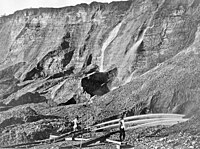
Photo from wikipedia
Abstract The Cripple Creek alkaline igneous rock-related low-sulfidation epithermal gold telluride deposit is hosted in a 10 km wide Oligocene alkaline volcanic diatreme in Proterozoic rocks. Periods of phreatic eruptions and… Click to show full abstract
Abstract The Cripple Creek alkaline igneous rock-related low-sulfidation epithermal gold telluride deposit is hosted in a 10 km wide Oligocene alkaline volcanic diatreme in Proterozoic rocks. Periods of phreatic eruptions and progressively more mafic alkaline magma emplacement created the diatreme and breccias that host the gold ore, followed by breccia pipe creation, and later by the emplacement of phonolite and later lamprophyre dikes throughout the diatreme. Pervasive potassic alteration affected much of the diatreme, and is spatially related to the late-stage veins containing native gold and precious metal tellurides. Previous studies have mainly focused on the high-grade gold veins primarily located toward the center of the diatreme. The current study evaluates the mineralogy and paragenesis of low-grade mineralization in the currently mined Wild Horse Extension (WHEX), Globe Hill, and Schist Island pits, and the Galena Embayment along the margin of the diatreme next to the WHEX pit, as well as high-grade mineralization in the WHEX and Cresson pits. Given the variable paragenesis of mineralizing stages in different locations in the Cripple Creek deposit, a simplified three stage paragenesis (stages 1, 2, and 3) is recognized here involving low- and high-grade gold mineralization. Scanning electron microscopy, electron microprobe, and laser ablation-inductively coupled plasma-mass spectrometry analyses are used to compare the trace element compositions of pyrite in low- and high-grade gold mineralization. These analyses reveal a complex trace element pattern with variability in Ag, As, Au, Co, Ni, Sb, and Te in the rims, cores, and zones (area between the core and the rim) of stages 2 (Py2) and 3 pyrite (Py3) and spatially between the pits currently being mined. Trace element concentrations in stage 1 pyrite (Py1) are lower than those in Py2 and Py3 and the patterns are uniform. Trace elements reside within the lattice structure of pyrite and as micro- and nano-inclusions (e.g., up to 48,220 ppm As, 6983 ppm Co, 12,250 ppm Ni, and 10,860 ppm Sb). The trace element patterns from the final stage of pyrite growth in high-grade gold telluride veins indicate enrichment in Ag, As, Au, Cu, Pb, Sb, and Te. The paragenesis and compositional zoning of pyrite associated with high-grade ore contrast with those associated with pyrite from low-grade ore, which preceded the formation of high-grade gold telluride veins. This suggests that metallic mineralization occurred in multiple episodes and that low-grade ore did not form from the same hydrothermal fluids that precipitated the high-grade ore. Early pyrite formed under passive, non-boiling conditions, followed by a transition to vigorous boiling in Py2 and Py3, ending with non-boiling conditions recorded in the Au and As-rich rims of Py3. This enrichment in Au and As on the rims of pyrite is consistent with other alkaline igneous rock-related epithermal Au deposits, as are the concentrations of trace elements throughout the pyrite grains. The presence of As, Ag, Co, Cu, Mo, Ni, Sb, Te, and Tl in pyrite are considered vectors to high-grade Au ore in the Cripple Creek deposit.
Journal Title: Ore Geology Reviews
Year Published: 2020
Link to full text (if available)
Share on Social Media: Sign Up to like & get
recommendations!